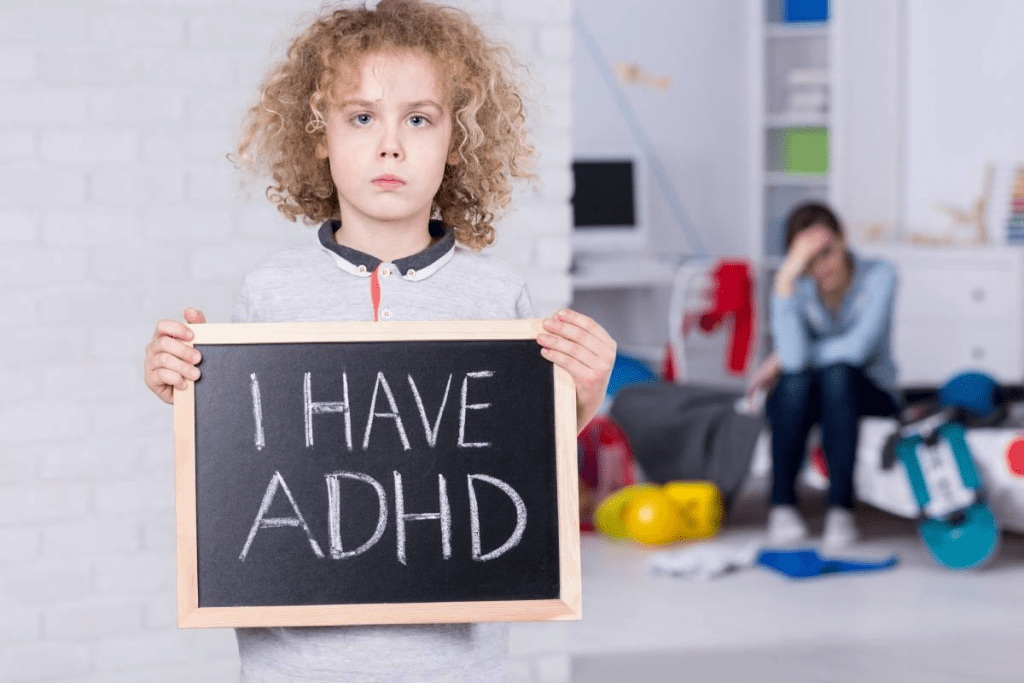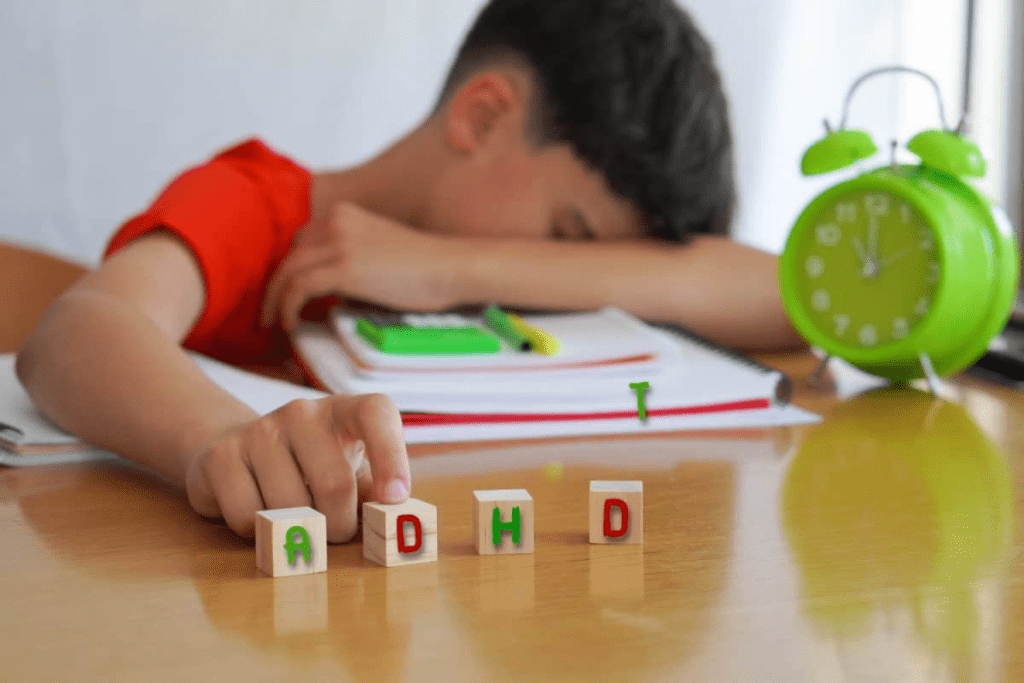Last Updated on November 14, 2025 by
Attention-Deficit/Hyperactivity Disorder (ADHD) is a complex condition that affects many children and continues into adulthood. It’s important to identify the signs of ADHD in kids early for diagnosis and intervention.
Research shows that ADHD symptoms usually start between ages 3 and 6. The median age of onset is around 6 years. This is a critical time, often during the early years of schooling, where symptoms become more noticeable.

When we look at the signs of ADHD in children, it’s key to understand how it peaks and its impact on their development and daily life. Early identification and support can greatly help them manage symptoms and thrive.
Parents and caregivers need to understand ADHD. ADHD, or Attention Deficit Hyperactivity Disorder, is a condition that affects how people focus, act, and control their impulses. It’s a neurodevelopmental disorder.
To be diagnosed with ADHD, symptoms must be seen in more than one place, like at home and school. This shows how vital it is to watch behavior in different settings to spot ADHD.
ADHD shows up in different ways in kids. Some mainly have trouble focusing, others are very active and impulsive, and some have a mix of both. Predominantly Inattentive Type makes it hard to stay focused and follow instructions. Predominantly Hyperactive-Impulsive Type is about being restless and interrupting others.
Spotting these signs is key to understanding ADHD’s impact on a child. It helps us see how it affects their daily life and growth.
The idea of “peaking” in ADHD means when symptoms are at their worst. Studies show ADHD symptoms usually peak in early to middle childhood. Knowing this helps us tailor support and care to meet the child’s needs at each stage.

By recognizing ADHD signs and knowing how it develops, we can support kids better. This helps them deal with challenges and get the care they need for their well-being.
Spotting ADHD in young kids is key to helping them. Kids this age are full of energy and curious. It’s hard to tell if they’re just being kids or showing ADHD signs.
Toddlers with ADHD often run, climb, or fidget a lot. They might find it hard to listen or focus on one thing. Impulsivity is another sign, like interrupting or acting without thinking.
Parents need to notice these signs early. But it’s also key to know the difference between normal toddler behaviour and ADHD. Getting advice from a pediatrician or child development expert is a good first step if you’re worried.
In kindergarten, ADHD symptoms can be clearer. Kids might have trouble sitting or following rules. They might also struggle to make friends because of impulsive actions.
Teachers and parents can spot these signs by watching how the child acts. Keeping a journal of their behavior can help track patterns and share with doctors.
Diagnosing ADHD in young kids is hard because every child develops differently. Some might grow slower or act in ways that seem normal for their age. A team of experts needs to evaluate them carefully.
Even though it’s tough, finding out early is vital. Knowing the signs of ADHD in toddlers and kindergarteners helps parents and caregivers support their kids.
The signs of ADHD in kids often become more pronounced during the early years of elementary school. At this stage, children are expected to follow rules, pay attention, and control impulses. This makes ADHD symptoms more noticeable.

Research shows that the median age of onset for ADHD is around 6 years. At this age, children’s environments change significantly as they enter elementary school. They are required to adapt to a more structured setting. This transition can make symptoms of ADHD more apparent.
Some common reasons why ADHD symptoms peak around this age include:
During elementary school, children with ADHD may exhibit a range of symptoms. These symptoms impact their academic and social functioning. Common symptoms include:
These symptoms can vary in severity and impact different areas of a child’s life.
The peak years of ADHD can have significant academic and social implications. Children may struggle with completing homework, following classroom rules, and interacting appropriately with peers. These challenges can lead to:
Understanding these challenges is key to providing the necessary support. It helps children manage their ADHD symptoms effectively.
As kids with ADHD grow into teens, their symptoms change a lot. This time is full of big changes in their bodies, feelings, and social lives. These changes can make ADHD symptoms show up in different ways.
One big change in teens is less hyperactivity and impulsivity. Teens with ADHD might not seem as hyperactive as younger kids. But, they might start to show it in smaller ways, like fidgeting or feeling restless.
Impulsivity might seem to lessen, but it’s hard for many teens. They can have trouble controlling impulses. This can mess with their friendships and how they make decisions.
Even though hyperactivity and impulsivity might lessen, inattention often stays the same. Teens with ADHD can find it hard to focus, follow directions, and finish tasks. This can really hurt their schoolwork, as they need to get better at organizing and managing time.
Inattention can also mess with their social life and activities outside of school. It’s important for parents, teachers, and doctors to help them out.
Adolescence brings new hurdles for those with ADHD. There are more schoolwork demands, social issues, and emotional ups and downs. Teens with ADHD face these challenges while trying to manage their symptoms. It’s really tough.
To help them, a strong support system is key. This includes special school help, therapy, and sometimes medicine. Understanding how ADHD symptoms change in teens helps us support them better. This way, they can reach their full abilities.
ADHD is often seen as a childhood issue, but it affects adults, too. It’s important to understand how ADHD symptoms change and stay the same as people get older.
Studies show that ADHD can last into adulthood, affecting about 4.4% of adults. This means many adults deal with symptoms that can affect their work, personal life, and relationships.
Research shows ADHD can last into adulthood for many. About 50-60% of kids with ADHD will have symptoms as adults. The severity of symptoms, other health issues, and treatment in childhood can affect this.
Adults with ADHD face different challenges than kids. They might have more trouble with focus, organization, and time management. These issues can impact their careers, money management, and personal lives.
Adult ADHD brings unique challenges. Adults often struggle more with planning, organization, and self-control. They may also find it hard to keep a job, manage money, and keep relationships strong.
Adults with ADHD are also more likely to have other mental health issues like depression and anxiety. It’s important to treat these conditions along with ADHD.
The idea that ADHD can start later in life is complex. While ADHD usually starts in childhood, some adults may show symptoms that weren’t noticed before. This can happen due to life changes, new demands, or hidden symptoms.
It’s also possible for adults to be misdiagnosed or not diagnosed at all. This is because ADHD can look different in adults than in children. A thorough evaluation by a doctor is key for a correct diagnosis.
ADHD severity comes from a mix of genetics, environment, and other health issues. Knowing these factors helps create treatment plans that meet each person’s needs at different life stages.
Genetics are a big part of ADHD. Studies show ADHD often runs in families. But the environment also plays a big role. This includes:
Good treatment and support are key to managing ADHD at any age. This includes:
Many people with ADHD also have other health issues. These can make diagnosis and treatment harder. Common issues include:
Understanding and tackling these factors helps doctors create better treatment plans. This improves life for people with ADHD.
It’s key to understand ADHD’s lifecycle to offer the right support. ADHD symptoms change from early childhood to adulthood. Signs in kids often show up in elementary school.
As kids with ADHD grow up, their symptoms can shift. Some may see less hyperactivity, while others keep struggling with focus. Whether ADHD worsens with age is complex. It depends on genetics, environment, treatment, and support.
Knowing how ADHD develops helps us support those with it better. This support is vital for their quality of life. It lets them reach their full abilities.
ADHD symptoms usually start between the ages 3 and 6. The average age is around 6 years.
Toddlers with ADHD might run a lot, climb, or fidget. They also have trouble following instructions and staying focused.
ADHD shows up in different ways in kids. Some are very inattentive, others are hyperactive and impulsive. Some kids have a mix of both.
ADHD symptoms usually reach their peak around age 6. This is when kids start elementary school.
Hyperactivity and impulsivity often lessen in teens. But inattention can stay the same or get worse. ADHD can also last into adulthood, but it might show differently.
Kids in elementary school might have trouble sitting, following instructions, and controlling impulses. These issues can hurt their schoolwork and social skills.
Teens with ADHD face new hurdles. They struggle with time management, organizing tasks, and keeping up with friends. Symptoms change, and hyperactivity and impulsivity often lessen.
ADHD is usually seen as a disorder that starts in childhood. It can last into adulthood, but it’s not usually diagnosed for the first time then.
ADHD’s severity depends on genetics, environment, and other health issues. Knowing these factors helps create better treatment plans.
Adults with ADHD might struggle with managing time, staying organized, and keeping relationships strong. These challenges can affect their work and personal lives.
Subscribe to our e-newsletter to stay informed about the latest innovations in the world of health and exclusive offers!